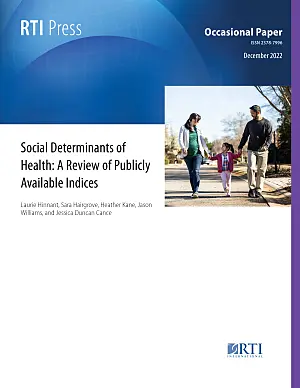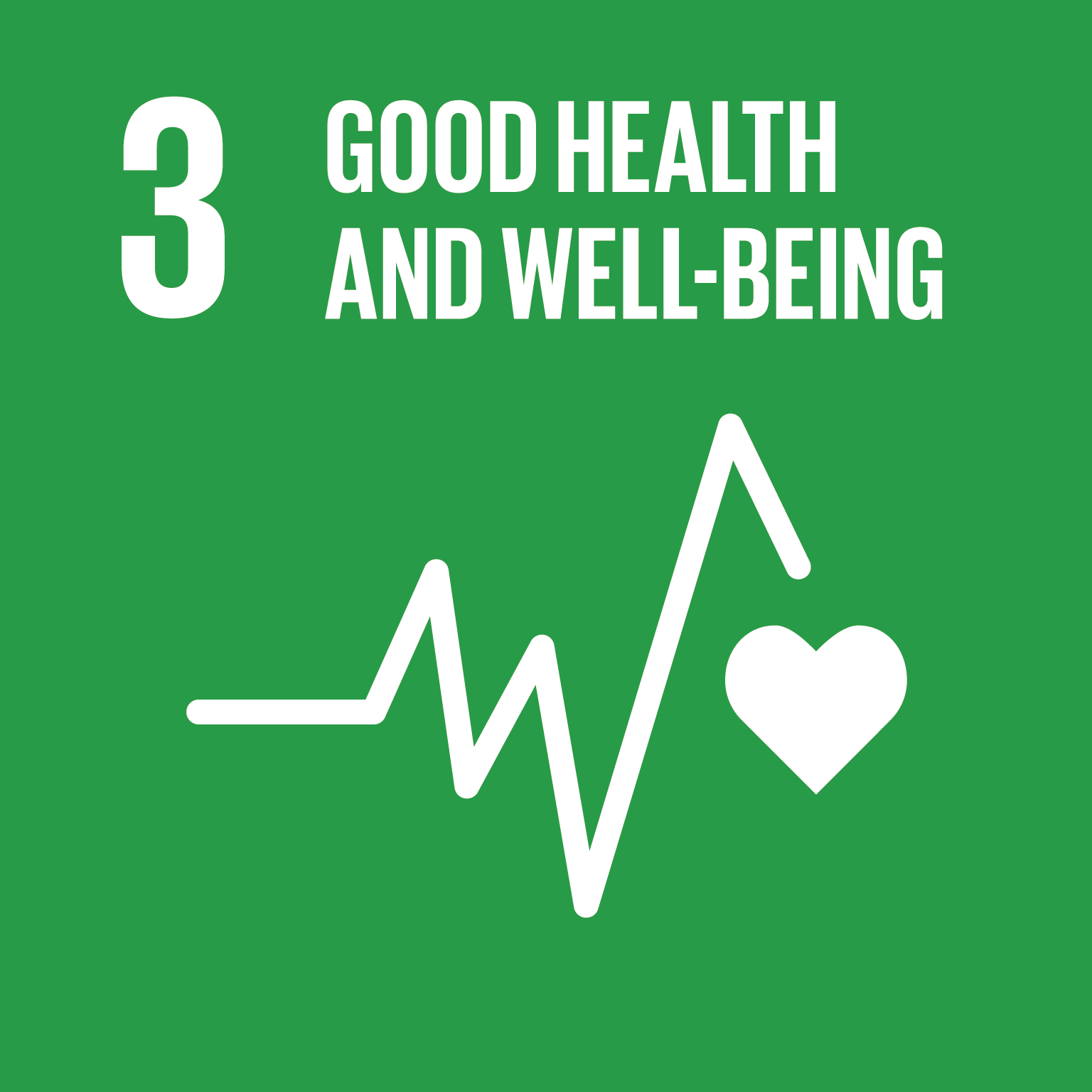Key Findings
Publicly available social determinants of health (SDOH) indices are not designed to be universal measures or compendia of measures that can be readily entered into statistical models. Each varies in its purpose and composition.
These indices draw from multiple data sources, such as the American Community Survey and Behavioral Risk Factor Surveillance System, and use different measures to conceptualize SDOH domains, such as economic stability, education access and quality, health care access and quality, neighborhood and built environment, and social and community context.
The composition of an index has multiple analytic implications for statistical modeling, including impacts that may skew the data or introduce collinearity.
Many of the data available today predate the pandemic and may not capture the current state of key SDOH factors.
Introduction
In recent years, social determinants of health (SDOH) research has rapidly gained traction. SDOH refer to “the conditions in the environments where people are born, live, learn, work, play, worship, and age that affect a wide range of health, functioning, and quality-of-life outcomes and risks” (Healthy People 2030, n.d.). These conditions are often grouped into domains: economic stability, education access and quality, health care access and quality, neighborhood and built environment, and social and community context. Each of these categories contains varied determinants, such as job opportunities, air pollution, and discrimination—all of which dramatically impact, and continually determine, one’s lifelong health and success (Healthy People 2030, n.d.).
The late twentieth-century Whitehall Study, which examined mortality in relation to employment grades, originated the concept of SDOH. Since that study was conducted, the importance of SDOH have been recognized by the US Department of Health and Human Services, the Centers for Disease Control and Prevention (CDC), and the World Health Organization, among other key public health agencies (Osmick & Wilson, 2020; US Centers for Disease Control and Prevention, n.d.). Recent expansions in policy and broader community efforts toward equity have further spotlighted SDOH research.
To effectively improve the well-being and health outcomes of a population, researchers and practitioners must continue to emphasize health disparities investigation. Dozens of publicly available indices and tools, such as data visualization dashboards, have been developed to measure and describe SDOH. Several of these are commonly used by researchers and practitioners to identify communities of greatest need. Each index comprises different measures with varied levels of geographic granularity. The differences among the indices should be considered by researchers when selecting the appropriate one to use to measure population-level health determinants (Elias et al., 2019). However, we lack a systematic assessment of indices or combination of indices to inform selection of indices for a particular study question of interest. This paper intends to provide researchers and practitioners a comparative overview of publicly available SDOH indices and considerations that should be made when selecting an index in line with the purpose of their work.
Methods
To identify common indices of SDOH, we started by holding brief discussions with public health experts to obtain information on indices of which they were aware and that are commonly used in the field. To supplement that information, we conducted a high-level environmental scan of publicly available indices (Rackers et al., 2019). We conducted Google searches, with keywords including social determinants of health, measurement/measures, index/indices, and data/data sources. Several organizations, including CDC (US Centers for Disease Control and Prevention, 2021) and the Rural Health Information Hub, have compiled lists of resources related to measurement of SDOH, and we also reviewed those. We identified a total of 16 indices that relate to understanding and measuring SDOH or their key components. We conducted a preliminary review of these indices to examine the specificity or breadth of SDOH measures included in each index (e.g., not just specific to one health outcome, included domains or measures that addressed several SDOH).
We selected six indices for in-depth review. They included publicly available data across a variety of common SDOH measures—health, environmental conditions, economics/socioeconomic status, crime and safety, and education, among others. We abstracted the indices, individual measures/items within the index, data sources, and frequency and recency of data into an Excel spreadsheet and then conducted a second abstraction to group common measures and data sources for comparison. Using this information, we selected five indices to include in this review. The Opioid and Health Indicators Database was dropped from this discussion because of its narrow focus on substance use and related health impacts.
Results
Our review includes five indices commonly used in SDOH research and practice (Table 1). Each index has a different sponsor and a different purpose. For example, the Social Vulnerability Index, sponsored by the CDC, focuses on identifying communities most vulnerable to disaster and least able to recover from such hardships; in contrast, the Opportunity Index, sponsored by the Forum for Youth Investment, emphasizes inequitable distribution of social advantage. Because of these differences in goals, the composition of each index also differs to align with its sponsor’s focus, even though all the indices provide a composite assessment of key elements of SDOH.
Table 1.
120312Summary of publicly available SDOH indices
Note: SDOH = social determinants of health.
As Table 1 shows, each index varies in the overarching domains, or constructs, that compose it. Domains include socioeconomic status, housing, transportation, household composition, education, community, health, physical infrastructure, equity, and others. Adding to the complexity, for many indices, each domain also consists of sub-domains. Within sub-domains, the individual measures further vary. For example, the Healthiest Communities index includes the domain of Population Health, under which are five sub-domains (Access to Care, Health Behaviors, Health Conditions, Health Outcomes, and Mental Health), under which there are 16 individual measures.
Across the indices, significant variability appears in what constitutes a domain, what the associated sub-domains are (and whether sub-domains are used), and what measures are included under each domain/sub-domain. The economy domain illustrates this variability. The Social Vulnerability Index includes a Socioeconomic Status domain, which does not include a sub-domain but includes four measures—Below Poverty, Unemployed, Income, and No High School Diploma. The Opportunity Index includes an Economy domain, which also does not include a sub-domain but includes seven measures: Jobs, Wages, Poverty, Income Inequality, Access to Banking Services, Affordable Housing, and Broadband Internet Subscription. The Healthiest Communities index includes an Economy domain that includes three sub-domains and their related measures: Employment (measures: Average Weekly Wage, Labor Force Participation, and Unemployment Rate), Income (measures: Households Receiving Public Assistance Income, Median Household Income, Medical Debt in Collections, and Poverty Rate), and Opportunity (measures: Business Growth Rate, Job Diversity Index Score, and Jobs Within a 45-Minute Commute). Although some areas overlap, these similar domains include very different sub-domains and measures. In several cases, measures like affordable housing or broadband internet are included in one domain in one index and in different domains in other indices.
Variability extends to the measures and data that are used to construct those domains and (if applicable) sub-domains. In Table 2, we provide examples of the many different measures and data sources used by these indices to examine the construct of Economy. For example, all five indices use a measure of Unemployment Rate. However, a deeper examination shows that these measures are drawn from different data sources. Two indices use the US Census’s American Community Survey, and three indices use the Bureau of Labor Statistics’ Local Area Unemployment Statistics. Similar examples can be seen in Table 3 when one considers the construct and measures of health. Three indices include a measure of adults with no health insurance coverage. Two of those use data from the US Census Bureau, and one uses data from the Behavioral Risk Factor Surveillance System.
Table 2.
120313Comparison of example measures for economy/socioeconomic status domain of SDOH indices
Notes: ACS = American Community Survey; SDOH = social determinants of health.
Table 3.
120314Comparison of example measures for health domain of SDOH indices
Notes: ACS = American Community Survey; BRFSS = Behavioral Risk Factor Surveillance System; CDC WONDER = Wide-ranging Online Data for Epidemiologic Research (US Centers for Disease Control and Prevention); SDOH = social determinants of health.
Examination of these indices shows that variability also exists in the geographic granularity of the data included. Many indices provide data at the state level and some other sub-state levels (e.g., county, county equivalent, census tract, ZIP code); however, not all data are available at the sub-state level. For example, the US Prosperity Index provides data at the state level but provides county-level data for only 1,196 counties in 12 selected states.
Another key consideration is the frequency and recency of when data are collected. Many publicly available data are not collected annually, or there is a delay between when data are collected and when they are available for analysis or when the most recent data are incorporated into an updated version of the indices examined. As a result, some data are several years old and of limited utility given rapidly changing community environments, especially since the COVID-19 pandemic. Many of the data available today predate the pandemic and may not capture the current state of key SDOH factors.
Finally, as discussed previously, each index has been constructed to meet the needs of the sponsor organization or agency. The domains, sub-domains, and measures have been carefully selected and crafted to capture the unique factors related to the outcome of interest, whether that be related to disaster recovery (Social Vulnerability Index), distribution of opportunity (Opportunity Index), patient-centered outcomes research (SDOH Database), community health (Healthiest Communities), or prosperity (US Prosperity Index). As such, the descriptive summaries from these indices have unique underlying statistical and analytical practices affecting the interpretation of these data. None of these indices has been designed to be a universal repository of SDOH measures that can facilitate in-depth modular, statistical analyses.
Discussion
With the growing interest in SDOH, researchers and practitioners may seek publicly available resources for assessing SDOH for their analyses. However, the publicly available indices are not designed to be universal measures or compendia of measures that can be readily entered into statistical models. Each varies in its purpose and composition, which can affect analyses. Researchers and practitioners must carefully assess each index to ensure alignment with their study question and theoretical framework, to establish validity and reliability, to reach accurate conclusions, and to appropriately identify areas for intervention. As a starting point, researchers and practitioners should explore what data elements and samples are included, at what geographic levels, and at what time points.
The composition of an index has multiple analytic implications for statistical modeling, including impacts that skew the data, introduce collinearity, and generate error. A researcher or practitioner should examine the underlying measures to ensure that the planned outcome of interest is not already embedded in the index, which would skew results. For example, the Opportunity Index includes drug-related deaths and, therefore, should never be included as an independent variable in a statistical model with opioid-related deaths as an outcome.
The timing and periodicity of the data collection and availability for the underlying measures also can affect the analyses and limit the conclusions. Data can become outdated and cannot keep up with rapid changes in a community (especially over the past 2 years). Even when data collection is ongoing (e.g., American Community Survey, Behavioral Risk Factor Surveillance System), data may not be available for about 2 years after data collection takes place. Thus, data availability may constrain study conclusions. When designing a study or using data to inform decision making, researchers and practitioners should consider how the timing of the data collection and availability affects potential findings, and they should describe potential limitations arising from the timing of the data collection and availability.
Many of these indices have weighting and other analytic adjustments based on the purpose of the index. Although researchers and practitioners may download raw data elements, they must account for these adjustments when determining whether one can break out individual measures or sub-indices for other analyses. For example, the Healthiest Communities index differentially weights each domain when developing its community rankings and conclusions. Domains and their weighting are: Population Health (14.2%), Equity (12.23%), Economy (11.1%), Housing (9.5%), Food and Nutrition (8.38%), Environment (8.6%), Public Safety (8.5%), Community Vitality (7.6%), and Infrastructure (7.5%).
Several indices also use small area estimation to indirectly estimate data for a geographic area smaller than the original design accounted for (e.g., estimating at the county level when the survey was designed to gauge state-level prevalence). Inherent challenges in small area estimation may not account for local variation (Kong & Zhang, 2020), and validity of the estimates is dependent on both the measure and neighborhood factors. Likewise, when the indices are constructed, sometimes data collected at one level may be aggregated to another level (e.g., county-level data aggregated to the state level). This aggregation can affect analyses and conclusions by ignoring community-level variability, potentially reducing the association between the SDOH index score and the health outcome of interest. Therefore, when using specific measures or indices, researchers and practitioners should carefully review associated data collection documents, such as the data dictionary, sampling procedures, and analytic procedures.
Finally, populations who are underrepresented in data collection are often those who are most affected by health disparities. Incarcerated and homeless individuals are not represented well in large survey data collection efforts; thus, researchers and practitioners must attend to the study sample to draw study conclusions.
Limitations and Future Directions
Our review is based on accessible SDOH indices, which are those publicly available for download. We did not include indices available by purchase. In addition, the scope of this review was limited to a qualitative review of the indices.
The next step in this work is to compare the indices quantitatively with a common health outcome, such as drug overdose deaths or diabetes prevalence, to assess whether the indices have differential impact, as we would expect given the differences between the indices noted in this review.
Conclusion
As more researchers and practitioners plan to integrate SDOH in their studies, they may consider options from the many publicly available indices designed to assess the presence or level of social determinants across the domains of economic stability, education access and quality, health care access and quality, neighborhood and built environment, and social and community context within their communities of interest. However, these indices are not interchangeable and have significant differences across domains of interest, included measures, and geographic granularity. To ensure that findings can provide actionable conclusions, researchers and practitioners should use theory-informed criteria when selecting the appropriate index or indices to use in their work.




